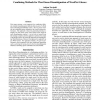125 search results - page 1 / 25 » Similarity-Based Methods for Word Sense Disambiguation |
ACL
1997
13 years 8 months ago
1997
We compare four similarity-based estimation methods against back-off and maximum-likelihood estimation methods on a pseudo-word sense disambiguation task in which we controlled f...
CORR
1998
Springer
13 years 7 months ago
1998
Springer
Abstract. In many applications of natural language processing (NLP) it is necessary to determine the likelihood of a given word combination. For example, a speech recognizer may ne...
FLAIRS
2004
13 years 8 months ago
2004
This paper presents a new approach for combining different semantic disambiguation methods that are part of a Word Sense Disambiguation(WSD) system. The way these methods are comb...
NLDB
2007
Springer
14 years 1 months ago
2007
Springer
Word sense disambiguation is the task to identify the intended meaning of an ambiguous word in a certain context, one of the central problems in natural language processing. This p...
AAAI
2011
12 years 7 months ago
2011
Effective access to knowledge within large declarative memory stores is one challenge in the development and understanding of long-living, generally intelligent agents. We focus o...

